Giant’s Basins, Great Slaughterhouse
Giant’s Basins from the The Great Slaughterhouse
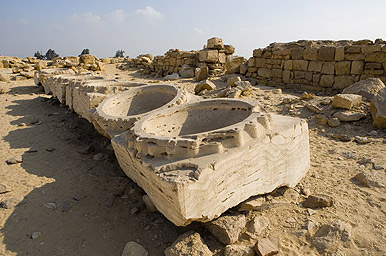 The Slaughterhouse Basins are large alabaster alters in which animals and/or humans were prepared for consumption.
The Slaughterhouse Basins are large alabaster alters in which animals and/or humans were prepared for consumption.
Location: About a quarter of the temple of Niuserre’s in Abu Gharab which means: “Father of the Ravens”.
was taken up by a large open court in its southeastern sector, while the northeastern quarter consisted of a series of storage chambers and an open space, referred to by Borchardt as the “Great Slaughterhouse,” because it was here that a number of large alabaster basins were unearthed. They consisted of circular bowls, carved out of roughly cubed blocks, which were positioned in cascading order, one after the other, so that the blood of sacrificed animals could flow freely down them.
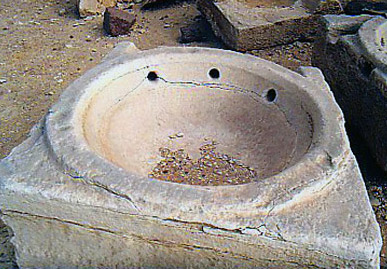 The limestone paving of this quarter, raised about 13 centimeters (6 inches) above the level of the surrounding court, contained grooves which could have facilitated the run-off of liquid.
The limestone paving of this quarter, raised about 13 centimeters (6 inches) above the level of the surrounding court, contained grooves which could have facilitated the run-off of liquid.
In his reconstruction of the structure, Borchardt also thought that there might have been a similar but smaller slaughterhouse in the northwestern corner of the temple.
Unfortunately however, Borchardt may have been entirely wrong in these assumptions. For example, in the “Sanctuary of the Knife” in the precincts of the Neferefre pyramid complex
at Abusir, anchored, conical stone blocks equipped with holes to tie down prone beasts before slaughter were present, but there are none of those in either the so-called Great or Small Slaughterhouses at this sun temple.
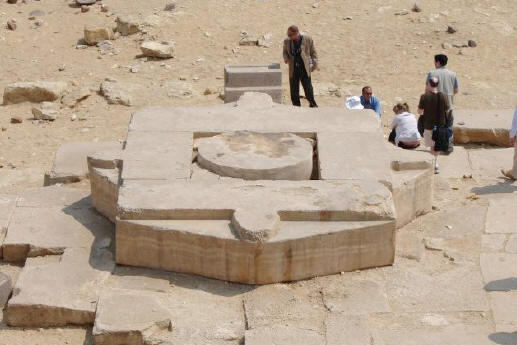 The alter itself, directly in front of (east) of the obelisk, was laid out in the open courtyard approximately in the center of the temple. It is a complex object, made up of five huge alabaster blocks. which may symbolize a rounded offering table or a stylized hieroglyphic sign for Ra, the sun god..
The alter itself, directly in front of (east) of the obelisk, was laid out in the open courtyard approximately in the center of the temple. It is a complex object, made up of five huge alabaster blocks. which may symbolize a rounded offering table or a stylized hieroglyphic sign for Ra, the sun god..
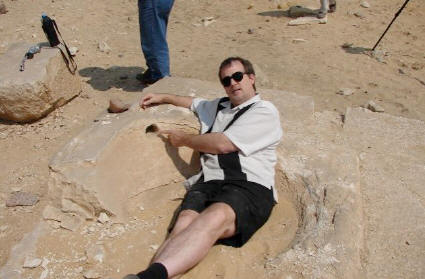 With this picture I wanted to show that these basins are human-sized. They are just the right size to contain a creature as large or larger than human. They are large enough to place a curled up large man on his side inside the bowl. This means of coarse that small children would be very small and well-contained inside the bowl. You can see the large hole drilled perfectly, evidence of advance machinery a drill as there is many many evidences for this type of drilling in Egypt for plumbing and electricity.
With this picture I wanted to show that these basins are human-sized. They are just the right size to contain a creature as large or larger than human. They are large enough to place a curled up large man on his side inside the bowl. This means of coarse that small children would be very small and well-contained inside the bowl. You can see the large hole drilled perfectly, evidence of advance machinery a drill as there is many many evidences for this type of drilling in Egypt for plumbing and electricity.
Some of the informational websites have stated that these Basins were only 3 feet wide, but as you ca see with this average size adult that that is a gross underestimate.
Take a moment to look around at the size of basins you use. Except for a crockpot most of use “movable” containers and containers that both women and children can carry. This being the case: are these containers easily “movable” by their users or are they grossly impractical? How big a person is needed to truly use these containers? Even the reach to the bottom of the bowl takes a tall long armed man, what about the opposite side of the bowl? It is too freat a distance and would require walking around, using a step or crawling on top. How were they used?
According to Plato’s version of the story, which originated in Egypt, Atlantis was a high civilization founded by the gods. They built a temple surrounded by a city formed of concentric rings, which was populated by hybrid god-men.
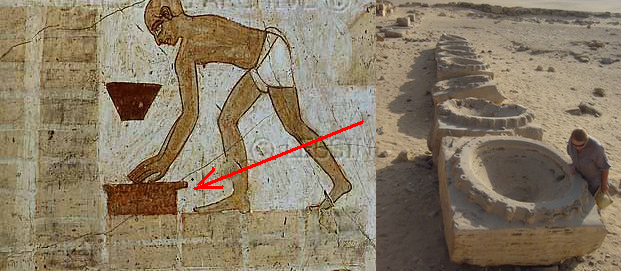 In the Tomb or Rekhmire you can see one of the Slaughterhouse basins being used. There appears to be a cap, and a third device above the slaughterhouse basin.
In the Tomb or Rekhmire you can see one of the Slaughterhouse basins being used. There appears to be a cap, and a third device above the slaughterhouse basin.
These three part preparation devices were used by beings of enormous size, as they must have needed a large consumption of food.
The Bible clearly states that “there were giants in the Earth back in those days” and here we can see what the slaughterhouse basins were used for.
Chris L Lesley Greater Ancestors World Museum
http://www.bibliotecapleyades.net/stargate/stargate10.htm
http://www.touregypt.net/featurestories/niuserresuntemple.htm
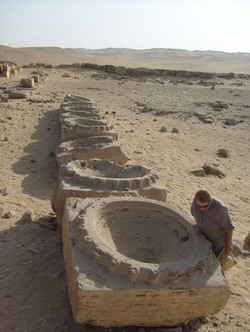
Comment